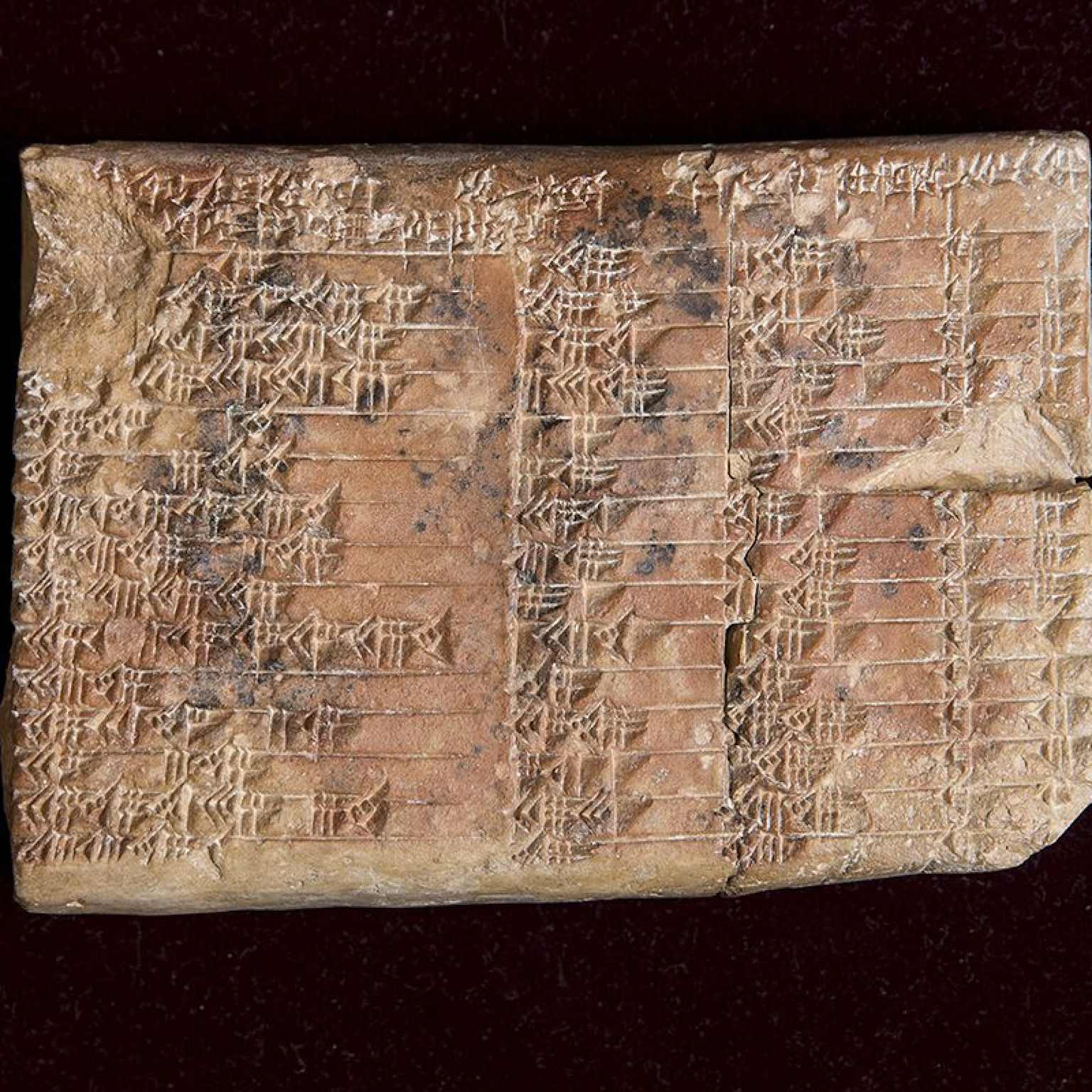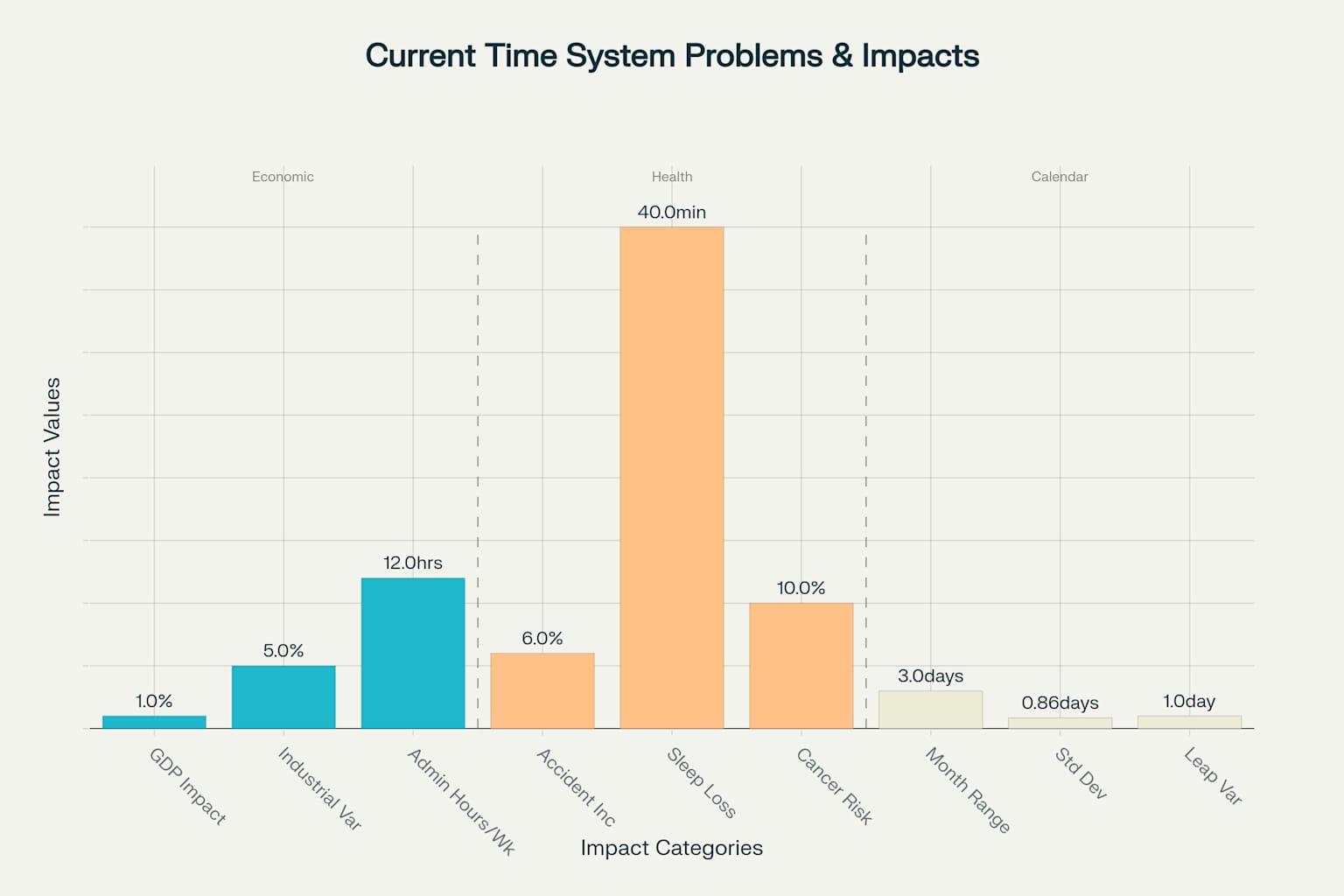Time for the Evolution of Time: A Comprehensive Proposal for Simpler, Human-Centric Clocks and Calendars

Modern timekeeping is a patchwork of ancient compromises that now fuels scheduling errors, health problems, and billions in avoidable costs. We can replace this complexity with a unified, mathematically clean framework that is easier to learn, healthier to live by, and cheaper to run.
1 Why Today’s Time Hurts
Current conventions survive only because they were inherited—not because they make sense.
1.1 Sexagesimal Relics
- Sumerian finger-counting in base-60 bequeathed us 60 seconds per minute and 60 minutes per hour, leaving 23.9h to a solar day.
- Babylonian cuneiform tablets preserve this numeration, still visible in museums today.

Ancient Babylonian clay tablet inscribed with cuneiform script, representing the historical use of a base-60 number system.
1.2 Roman Politics and Gregorian Patches
- The Roman ten-month calendar added January & February later for political optics, leaving irregular month lengths12.
- The monk Dionysius in 525 started A.D./B.C. counting our "years" since Jesus but miscalculated his birth year. Pope Gregory’s 1582 reform skipped 10 days to fix drift but kept the uneven pattern and omitted a year 0, complicating arithmetic with B.C./A.D. boundaries34.
1.3 Operational Costs
| Source of waste | Documented impact | Mechanism |
|---|---|---|
| Day-count conventions in finance | up to 1 pp change in quarterly GDP[^3] | Irregular month lengths distort economic series |
| Industrial output swings | > 5 pp per month[^3] | “Bridge-day” effects & variable workdays |
| Administrative scheduling | ~12 manager-hours/week/firm5 | Annual re-design of rosters and reports |
A Johns Hopkins analysis estimates calendar chaos costs ≈ $130 billion annually in miscalculations and rescheduling6. It is hard to calculate long ranges, accounting for leaps, or uneven days in month-to-month ranges.
1.4 Health & Safety
- Daylight-saving transitions raise accidents 6% the following week78.
- Living on the western edge of a time-zone increases cancer risk 5–10% via circadian misalignment[^2]9.

Comprehensive Analysis of Current Time System Problems and Proposed Solutions
2 Principles for a Better System
- Decimal intuition – express time as percentages or powers of 10, matching other SI units.
- Perennial predictability – identical calendar grids every year for friction-free planning.
- Biological alignment – anchor local schedules to sunrise instead of artificial offsets.
- Data-ready notation – a single numeric string parses cleanly by humans and computers.
3 Daily Percentage Time (d-time)
| Legacy time | d-time | Mental rule |
|---|---|---|
| 1 h | 0.042 d | “4% of the day” |
| 15 min | 0.01 d | “≈1%” |
| 2h 24m | 0.1 d | "a tenth" or 2.4h |
| 3:40 a.m. | 0.15 d | hour × 0.04 + min/1440 |
Practical speech: “Spend two percent on lunch” ⇒ 0.02 d = 28 min 48 s.
4 A Perennial 36-Day 10-Month Calendar
4.1 Structure
- 10 months × 36 days = 360 days (+ 5/6d for year)
- Each month: 6 weeks × 6 days
- Fixed rest days: 5th, 11th, 17th, 23rd, 29th, 35th of every month, Fridays vary
- Year-end 5 Celebration Days of 5 days (6 in leap years) for festivals, audits, backups.
This keeps quarters equal (3 months = 18 weeks = 108 days) and makes fiscal, academic, and project cycles perfectly regular.
4.2 Calendar Grid
█████████████████████████████████████████ 75% (6:00pm)
| 1 | 2 | 3 | 4 | 5 | 6 |
|---|---|---|---|---|---|
| 7 | 8 | 9 | 10 | 11 | 12 |
| 13 | 14 | 15 | 16 | 17 | 18 |
| 19 | 20 | 21 | 22 | [23] | 24 |
| 25 | 26 | 27 | 28 | 29 | 30 |
| 31 | 32 | 33 | 34 | 35 | 36 |
- 3gc AI: 275d
- 3g 7m 23d
- 3.7.23.75d
- (7/5/2025 6PM) (legacy)
4.3 Leap Logic
Add one festival day when the solar year demands, following: divisible by 4 ⟹ +1 unless divisible by 100 ⟹ –1 unless divisible by 400 ⟹ +1 unless divisible by 3200 ⟹ –1. Net drift < 1 day in 20 000 years—six times better than Gregorian.
5 Sunrise Universal Number (SUN)
Instead of “UTC+9” or “PDT–7,” reference local civil events to 6am sunrise = 0d
- Work window: 0.1–0.5 d (08:36–5:00p old time).
- Global conference call at 0.60 d means every participant meets ~14:24 after their own sunrise—no conversions.
- Universal Standard: Can be written as 2025.7y 12.7d -0.7d
- convert UTC offset hrs x 1.2 - 6 = SUN offset
5.1 Exponential Day Dating
Define long spans in scientific notation of days (d):
- Big Bang ≈ 5 × 10¹² d
- dc = "days of computers" since Unix epoch (1970-01-01)
- Typical lifespan EU = 30Kdc ⇒ 82 y
This single-unit scale removes BCE/CE discontinuities and negative-zero confusion.
6 Historical Ages, Computer Gens
- 10000dc=1 generation, 10gc = 1 Era, 10 Eras = 1 Age = 1Mdc = 1000Kdc
- Historic Age ⇢ 768 BCE (-1Mdc) - Mar 17, 1696
- Science Era ⇢ Mar 17, 1696 (-1gc) - Dec 31, 1969
- Computer Era ⇢ Jan 1, 1970 UTC (0day) - Oct 17, 2243
- 0th, Microprocessor Gen ⇢ Jan 1, 1970 - May 18, 1997
- 1st, Internet Gen ⇢ May 19, 1997 (1gc) - Oct 3, 2024
- 2nd, AI Gen ⇢ Oct 4, 2024 (2gc) - Feb 19, 2052
7 Standardized Numeric Formats
// Javascript for current _dc_
Date.now()/864e5
// dc of this generation of computing
Math.floor(Date.now()/864e5) % 10000;
- July 5, 2025 4am UTC = 20274.4560dc or 274d (may omit 2g)
- 2025.6 y 4.63 d ⇢ six-tenths (months) into the year plus 4.63 days
- 40-75 %d ⇢ work hours of 9:30a-6pm (UTC sunrise at 7am)
- 0.75 d ⇢ sunset -+.05
- 2 %d ⇢ half an hour ("I'll see you in 2 percent after lunch break")
Conversion constants:
| Unit | Conversion |
|---|---|
| 1 gc | 10,000 d |
| 1 y | 365.2425 d |
| 1 d | 0.002737 y = 86 400 s |
| 1 s | 0.000011574 d |
| 1 h | 0.041667 d = 3 600 s |
| 1 min | 0.000694 d = 60 s |
8 Transitional Path
- Embed d-time converters beside digital clocks; payroll already logs decimal hours.
- Dual-label calendars for five years; software libraries publish ISO-36-Week tables.
- International agencies switch fiscal reporting to perennial quarters; airlines adopt SUN in timetables.
- DST laws sunset; sunrise-aligned civic hours phase in.
9 Expected Gains
- Cut scheduling overhead > 80% by eliminating annual template rebuilding56.
- Reduce DST accident surge, saving hundreds of lives yearly7.
- Synchronize remote teams without mental arithmetic, improving collaboration speed.
- Provide children a time system they can reproduce with primary-school fractions, not phone apps.
10 Conclusion
We inherited hours, minutes, months, and time-zones from priests, emperors, and railroad barons. Their constraints are now ours to discard. A percentage day, a regular calendar, and sunrise-anchored locality restore timekeeping to human logic and biological sense.
Footnotes
-
https://en.wikipedia.org/wiki/History_of_timekeeping_devices ↩
-
https://knowledgebasedsociety.com/sumerian-sexagesimal-system-and-time-invention/ ↩
-
https://www.vox.com/2016/10/4/13147306/434th-gregorian-calendar-anniversary-google-doogle ↩
-
https://rauantiques.com/blogs/canvases-carats-and-curiosities/a-brief-history-of-timekeeping ↩ ↩2
-
https://mathsciencehistory.com/2021/11/09/count-to-60-with-your-phalanges/ ↩ ↩2
-
https://cdn.preterhuman.net/texts/other/crystalinks/romecalendar.html ↩ ↩2
-
https://www.timeanddate.com/calendar/julian-gregorian-switch.html ↩
-
https://www.scientificamerican.com/article/a-chronicle-of-timekeeping-2006-02/ ↩